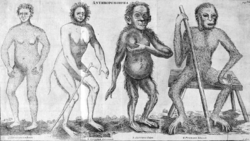Biology:Anthropomorpha

1. Troglodyta Bontii, 2. Lucifer Aldrovandi, 3. Satyrus Tulpii, 4. Pygmaeus Edwardi
Anthropomorpha (original spelling: Antropomorpha[2]) is a defunct taxon, replaced by Primates.[3]
The order was established by Carl Linnaeus in the first edition of his book Systema Naturae (1735) for genera Homo (humans), Simia (monkeys and apes in general) and Bradypus (sloths).[4] The taxon is notable for the history of human taxonomy as the first to combine apes (Linnaeus' Simia) and humans under the same clade.[5]
In the 1758 edition of the same book, Linnaeus discarded this name and began to use the word Primates, which has replaced Anthropomorpha completely. A dissertation on the Anthropomorpha was published by Linnaeus' student Christian Emmanuel Hoppius in 1760.[6]
The name is no longer considered valid, as the animals that were included within Anthropomorpha are now believed to belong to multiple clades. For example, two-toed sloths were included within Anthropomorpha,[7] but are now considered to be in the family Choloepodidae, which is not closely related to the primates.[8] Comte de Buffon [year needed] correctly rejected the combination of sloths and primates within the same order.[7]
References
- ↑ C. E. Hoppius, "Anthropomorpha", Amoenitates Academicae vol. 6 (1763).
- ↑ Linnaeus, C.: Systema Naturae 1748 [1]
- ↑ Porter, N., ed (1913). "Anthropomorpha". Webster's Revised Unabridged Dictionary. G & C. Merriam.
- ↑ Linnaeus, C. (1735). Systema naturae sive regna tria Naturae systematice proposita per classes, ordines, genera, & species. apud Theodorum Haak, Lugduni Batavorum. pp. s.p.
- ↑ Sven Horstadius, Linnaeus, animals and man, Biol. J. Linn. Soc. 6 (December 1974), 269–275 (p. 273).
- ↑ C. E. Hoppius (6 September 1760). "Anthropomorpha". Amoenitates Academicae. http://fmhibd.library.cmu.edu/HIBD-PDF/LinnaeanDiss/Liden-111.pdf.
- ↑ 7.0 7.1 Conniff, R. (December 30, 2007). "Forgotten, Yes. But Happy Birthday Anyway". New York Times. http://travel.nytimes.com/2007/12/30/travel/30Cultured.html.[unreliable source?]
- ↑ Gardner, A. (2005). Wilson, D.E.; Reeder, D.M.. eds. Mammal Species of the World: A Taxonomic and Geographic Reference (3rd ed.). Johns Hopkins University Press. pp. 101. ISBN 978-0-8018-8221-0. OCLC 62265494. http://www.departments.bucknell.edu/biology/resources/msw3/browse.asp?id=11800016.
 |

